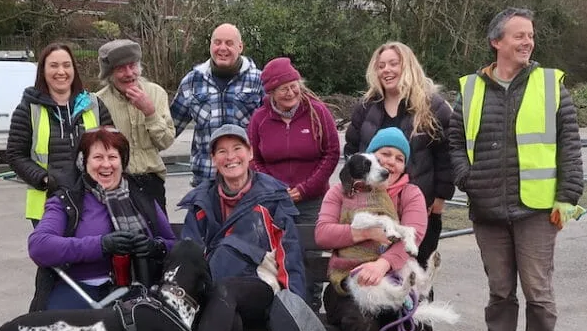Betsy Gorman: Bring Back The Wild

Almost every town has a patch of green: garden, road verge, park, or even the odd tree. Even in our most urban environments people, as a general rule, enjoy this connection to nature and flock to these areas to hold events, exercise, or simply to relax in the sun. In short, they’re a community hub. But in an age of climate fears and biodiversity loss, could they be more?
The BLUE campaign was founded as a pilot study in Chipping Sodbury in response to the RSPB state of nature report. Our message was simple – everyone should have the chance to bring wildlife into their lives. Working under the principle that setting aside even a small amount of land to go wild, people could create habitat niches for different species and step away from monotonous grass lawns. Starting from grass, wildflower and ‘weed’ growth (although I hesitate to use the word weed), you can provide resources for insects, birds, and mammals. Your own little food web. Even a windowsill or 2m X 2m patch could create an additive effect to the point where, when more people joined in, the effort becomes less about individual gardens, and more about the whole town.
Towns like Ringmer, Bookham, Royal-Wootton basset, and more have adopted the BLUE heart as a symbol of their small-scale rewilding projects. Our most recent example is Caterham. BLUE sites here are being run and funded by Caterham on the Hill parish council, led by Councillor Kerry Mansfield. BLUE hearts were created by The Men in Sheds at The Westway Centre in Caterham and individually painted beautifully by all members of the community. A group effort towards a shared reward, waiting for spring to bring benefits to their local wildlife.
Why is this important? Speaking from an ecological standpoint, setting aside just a little bit of grass to wild can seem so small in such a dauntingly massive task as combating biodiversity loss. And yes, if isolated, these patches will not always have the desired effect because the connections to other habitats just aren’t there. Butterflies, bees, and other insects, for example, require multiple and varied flowering habitats to survive. Our favourite spikey garden visitor, the hedgehog can travel nearing 12 miles a night, but if the food and shelter isn’t there for them, they are vulnerable to even greater declines. Alone, urban landscapes can seem impenetrable fortresses to nature. But what if your rewilded garden sparks a conversation with your neighbour? What if your neighbour tells theirs, and so on until the whole street is involved? Maybe someone on that street emails a council member who proposes a wild site on the town park or road verges. Suddenly, you’re not just looking at an isolated garden of wildflowers, log piles, and long grass, but a network of interconnected habitats that let animals and plants move more easily through a human dominated landscape.
The BLUE heart symbol staked into a piece of wild scrub or ‘weed’ filled long grass shows that that person is dedicating their bit of land to wildlife. This space hasn’t been lost to neglect but is now being shared with multiple species. We can still enjoy our green spaces and be a part of, not apart from nature. While it isn’t going to be for everyone, from starting at BLUE in 2017, I have seen the momentum build from one town to a community of 1000s across the UK and beyond.
As we enter the next UN Biodiversity Conference, its important to know how the big projects are combating species loss and it’s also important to see what you can do too. BLUE brings rewilding theory and practice into homes and gives people a chance to make a difference. Our community just keeps on growing and I’m excited to see where we go next.
Want to join us? Check out our website bluecampaignhub.com or our thriving Facebook group. We look forward to welcoming you into our rewilding community!

Betsy Gorman is the Campaign Director for the BLUE campaign. She is an ecologist and artist, aiming to encourage people to live alongside nature and hoping to build a career in urban ecological research. Her primary role as director is facilitating local rewilding projects and networks, including communicating with councils and the public on how to start up wild sites in their area.
Recommended from Carbon Copy
-

Copy These! 5 Big Local Ideas About Using Decentralised Energy
Communities around the UK are generating their own electricity - through solar, hydro and wind. But how can they ensure…
-
 Affordable Energy, Buildings & Places, Climate Action, Good Food, Greater Fairness, Health & Wellbeing, Less Waste, More Jobs, Strong Communities
Affordable Energy, Buildings & Places, Climate Action, Good Food, Greater Fairness, Health & Wellbeing, Less Waste, More Jobs, Strong CommunitiesCopy These! 5 Big Local Ideas About Creating A Community Hub
Learn how communities are reinvigorating once-forgotten spaces, to bring local environmental, social and economic benefits.